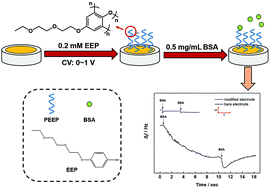An antifouling polymer for dynamic anti-protein adhesion analysis by a quartz crystal microbalance
Abstract
Nowadays, the non-specific adsorption of biomolecules is a key issue in numerous fields. Herein, an improved antifouling molecule was synthesized by grafting phenol with oligopoly (ethylene glycol), named (4-(2-(2-ethoxyethoxy) ethoxy) phenol (EEP). An ideal antifouling polymer coating (PEEP) was synthesized by the mechanism of electropolymerization of phenol. Quartz crystal microbalance (QCM), a sensitive mass sensor, was used to dynamically monitor both the modification and anti-protein adhesion (with bovine serum albumin as the model) process. Quantitatively, less proteins were observed to adhere to the modified electrode (277.8 ng for bare GCE and 8.88 ng for the modified GCE). Fourier transform infrared spectrophotometry (FT-IR), scanning electron microscopy (SEM), and electrochemical methods were used to study the coatings in detail. In this study, EEP was synthesized for the electrochemical preparation of an antifouling coating and characterized by QCM and electrochemical methods. The mild preparation environment (lower potential window and in phosphate buffered saline) and one-step method enable potential applications of PEEP in the field of biomaterials and biosensors.



 Please wait while we load your content...
Please wait while we load your content...